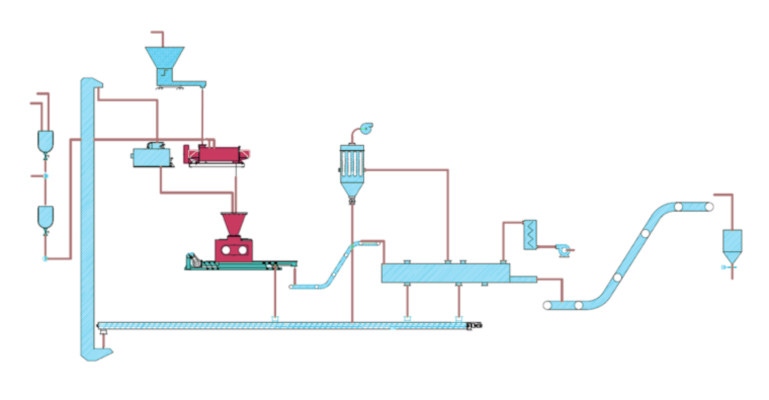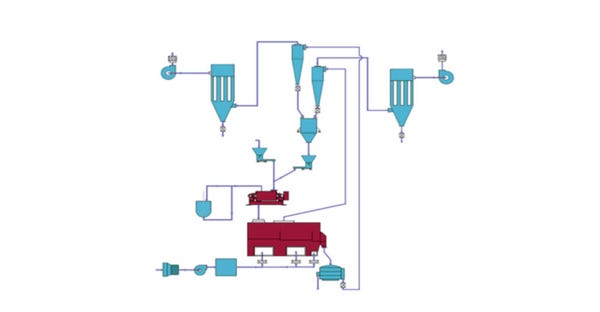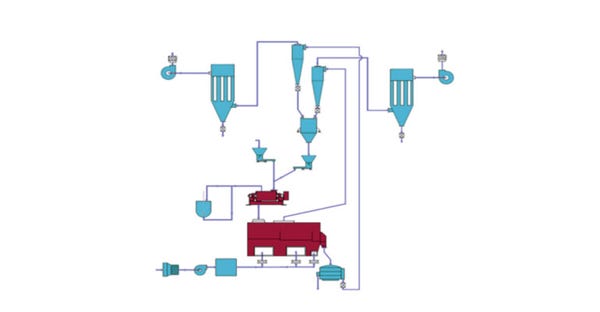Agglomerating and Drying Go Hand-in-Hand
Selecting the right drying process means understanding how it works with the agglomeration method and the effect of the dryer on the material properties.
April 6, 2021

John Heapy, process development manager, Bepex International LLC
Many factors affect agglomeration system design, not the least of which is the choice of dryer. Dryers can influence the properties of the finished product. Selecting the right drying system can have a significant impact on investment and processing costs, finished product quality, and the product’s performance. Selecting the right drying process means understanding how it works with the agglomeration method and the effect of the dryer on the material properties.
Particle agglomeration is an important step in the food, chemical, and mineral industries. Agglomeration often carries the requirement of drying or curing the agglomerates, adding an independent step to the process. But it’s more efficient to consider the process as a whole. The dryer itself can impact the final properties of the product. Several dryer/agglomerator combinations will meet requirements, so understanding the agglomeration step, the drying step, and the combination of the two will help to optimize the process and results.
Drying is a separation process in which the liquid portion of a mixture of solids and liquids is removed by non-chemical means. This generally requires heating the mixture to volatilize or evaporate the liquid. In most cases, the material leaving an agglomeration device and entering a dryer will be soft, since the process relies on drying for curing. Many products, like briquettes, cannot tolerate any breakdown during drying. Granules, on the other hand, can enter the dryer with a slightly larger overall particle size distribution, with the expectation that some particle polishing and size reduction will occur.
In a majority of agglomeration systems, the volatile being removed is water. In general, this would suggest direct drying. Although agglomeration systems receive feed material in a variety of forms such as powders, wet cakes, slurries, or even solutions, a post dryer will receive a formed product, such as a pellet, briquette, or granule. The size, shape, final moisture, and strength (both green and final) define the dryer type.
After drying, cooling may or may not be required. However, materials often leave a direct dryer at temperatures above that required for safe packaging. Coolers could be stand-alone units but are often supplied as an additional zone in the dryer itself.
The following examples describe typical processes for selecting a drying system based on application need and parameters.
1. Belt Drying: Briquetting Larger Particles Using a Binder
Several devices can convert a powder of fine granular material to particles over 12 mm: roll presses, ring and die pellet mills, or high-pressure screw extruders. Most materials will form under pressure alone, although some materials benefit from the use of a binder or simply additional water. Charcoal, coal, animal feeds, cereals, alloying agents, and various ores are examples of materials that can be briquetted with a binder and dried on a belt dryer.
A roll press converts the material to the final product: 15 to 300 mm and almond- or pillow-shaped. Most materials discharged from the briquetting rolls are soft in their green or uncured state, so gentle handling is required. Very likely, the binder is water or water-based, which suggests direct drying. Because of the larger product size, moisture diffuses from the center to the surface, and the process will require a longer drying time. Drying temperature could be limited, both to preserve product shape and to avoid product degradation or combustion. Additionally, cooling before packaging or stockpiling might be required.
A belt dryer is an ideal option for larger briquette drying because of the relatively slow product movement and handling. The material to be briquetted is mixed, usually continuously, with either water or the binder ingredients. A briquetting press forms the material and also removes fines via a vibrating screen device. The fines can be recirculated directly to the briquetting press, which creates a more homogenous blend in the briquetter. Once formed, the briquetted product is gently conveyed to the belt dryer.
The belt dryer incorporates a porous belt and is designed to ensure proper airflow through the bed. The bed depth is controlled by rate and belt speed; drying time is controlled by the length of the belt. Exhaust air passes through a baghouse, where the small amount of fines are collected and recycled. Fines that fall through the belt are also recycled. Because these fines are dry, they would normally be directed back through the mixer to be rewetted.
2. Indirect Drying: Particle Size Enlargement of a Solvent-Laden Powder
Many materials require solvent-based processes to counteract reactions (i.e. polymers such as PPO, PPE, PE and fluoropolymers). In other cases, byproducts of filtered materials (i.e. industrial sludges and specialty chemicals such as resins) contain solvents and create handling or disposal issues. In all cases, the fine particle size and low bulk density create the need for agglomeration.
Indirect drying is the ideal choice for solvent-laden materials because it minimizes the amount of sweep gas and allows for the use of inert gases. Most indirect dryers rely on mechanical agitation—usually some type of rotating device—since there is insufficient gas flow to move the material. Rotating devices include screws, paddles, or ploughs. Agitators tend to break down agglomerated materials, especially in the freshly formed or green state, so agglomeration is best done after drying when using an indirect dryer.
Indirect dryers include paddle, plough, disc, and tube. A disc dryer offers a large surface area in a small space. Coupled with the low volume of sweep gas, this results in a compact system that is economical to operate. Moisture levels are controllable, but residual solvent levels in the parts-per-million range are possible. These solvents can be recovered, leading to minimal environmental impact.
A high-pressure roll press agglomerates the material. A conventional compaction/granulation system will produce uniform-sized granules. A once-through system with roll compaction followed by milling is ideal for simple densification. If larger pieces are required, briquetting rolls create the required dimension. In all cases, controlled pressure applied to the powder forms medium to hard masses. Screening and optional milling control final size.

A disc dryer processes solvent-based materials and offers large surface area in a small space.
3. Water-Dispersible Granules from Powders
Examples of materials processed through stand-alone granulation include feed additives, drink mixes, detergents, ag chemicals, nutraceuticals, pigments, or dyes. If the agglomeration system is used as a product enhancement, the powder may already exist in a dry form. The product may also be sold in two forms--powders and granules--or may require fine-milling prior to granulation. Roll compaction is not an option for dispersible granules because it tends to make the final product hard and dense.
Two methods that produce dispersible granules are mixing or low-pressure extrusion. Both methods require mixing a powder and liquid. The final product size may be in the range of 100-2,000 microns and the mixer and can discharge directly into a dryer. The binding agent is typically water or a water-based solution. To grow granules in a mixer, the fine material is wetted, causing the individual particles to stick together. These freshly formed granules are very soft and cohesive on the surface.
Direct drying is optimal for processing water and soft particles. Of the direct-drying options, a fluid bed dryer offers gentle agitation, effluent gas contact and moisture stripping.
The agglomeration mixer or extruder is mounted directly on the inlet of the fluid bed. The fluid bed uses air of sufficient velocity to keep the bed in a state of turbulence. The fluid bed box can be fixed or vibratory and is divided into three zones.
Air in the first zone may have higher velocity and temperature. The wet granules remain separated and are case hardened. Wet agglomerates enter a bed of partially dried granules, which prevents further product growth. As the moisture is removed, the granules become lighter and directional screens move the granules toward the second zone. As new granules enter, partially dried granules overflow to the next zone.
Lower air temperature in the second zone creates a longer retention time, allowing for the granules to fully cure. In the third and final zone, additional drying allows for packaging and cooling. The fluid bed action polishes particles, and the high airflow through the beds removes dust. Granules can be screened and sizes as they exit, although they are often clean enough for packaging. Fines and dust are recycled to the agglomerating device. Oversized material can be pulverized for re-agglomeration or crushed to size and screened.

A fluid bed dryer offers gentle agitation, effluent gas contact, and moisture stripping.
4. Granules from Wet Cakes
Examples of materials processed as granules from wet cakes include feed additives (amino acids, vitamins and antibiotics), lithium carbonate, organic fertilizers, and protein powders.
Wet cakes are produced by mechanically removing water using a filter or centrifuge. There are many ways to process wet cakes. They can be extruded or conditioned in pin mixers. They can be rolled in drum or pan agglomerators. Due to the variety of product size and shape, there are many different direct dryer types for different agglomerators. Agglomeration processes and drying solutions include:
• Pin mixer ➝ Fluid bed
• Drum or pan granulator ➝ Drum dryer
• Small extrudate ➝ Fluid bed
• Large extrudate ➝ Belt dryer
The situation again calls for pre-drying all of the material followed by post granulation of a portion of it. Since the powder will be dry, the agglomeration methods available are high-pressure extrusion or high-pressure compaction. High-pressure compaction could be in the form of roll pressing, slugging or tableting. The choice will depend somewhat on the material, but for the most part, roll compaction systems are best suited to produce granules.
Many types of dryers transform the wet cake to powder, especially when removing water: rotary dryers, flash dryers, dispersion dryers, belt dryers, or tray dryers. Of these, a dispersion dryer is the best alternative to ensure a powder is discharged.
A dispersion dryer is based on a flash dryer but uses a low-intensity mill to break up lumps and disperse the wet cake into the hot air stream. Because of the high moisture, high-temperature air can be used, and evaporative cooling tends to control product temperature. These factors lead to increased dryer efficiency.
A feeder delivers the wet cake to the dispersion unit. The wet feed moves through the dispersion chamber under heated air; a medium-intensity rotor breaks up lumps and combines the streams. This air/powder mixture is drawn through cyclones or baghouses where the product is separated from the air. The air can be directly or indirectly heated.
Product from the baghouse can be flash-cooled for packaging or diverted to the granulation system, which presses the material into sheets or flakes. The flakes are milled and screened to the required size.

Roll compacting systems are best suited to produce granules.
Summary
Just as there are many options for agglomeration there are many types of dryers to go along with them. It’s important to evaluate the process requirements as a whole and consider all the variables: volatile content and type, wet material and dry material consistency, and properties most important in the end product. Knowing these parameters creates a successful system that operates efficiently and effectively.
John Heapy is process development manager, Bepex International LLC (Minneapolis, MN). Bepex serves the global food, chemical, and polymer markets by providing process development services and custom-designed industrial scale process systems and equipment. For more information, call 612-400-8623 or visit www.bepex.com.
You May Also Like


